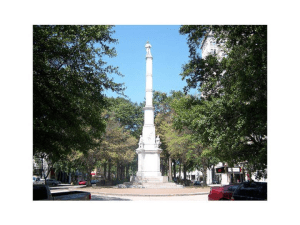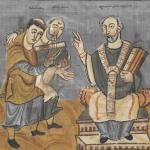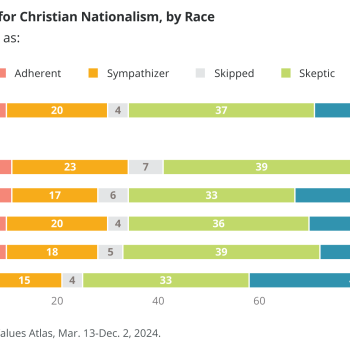Unlike a number of my colleagues at the Anxious Bench, I’m not currently a professor. I’m an administrator, spending my days as an advisor to Baylor’s president, Linda Livingstone, considering issues of equity, justice, and community engagement. Throughout the last few years, I had the privilege of working on a project that will shape Baylor’s future by more justly articulating and reckoning with its past. On February 23, 2024, we gathered on Founders Mall on Baylor’s campus to break ground on a memorial to the enslaved persons who built Baylor’s original campus. Soon Baylor will join the ranks of Brown, UVA, and other colleges and universities that have, in the last few decades, erected memorials to the enslaved, recognizing that many of the country’s older institutions of higher education were constructed by exploited and stolen labor. It was a historic moment and a heavily attended ceremony, though it was a ceremony of intent. Construction will begin after graduation, but the long process of healing has only just begun.
This process began back in 2020 when Baylor’s Board announced a Resolution on Racial Healing and Justice, explicitly articulating that Christianity and racism have nothing in common as well as committing the university to seek the building of just and equitable systems. Paired with this was the creation of the Baylor Commission on Historic Campus Representations made up of students, faculty, staff, regents, and alumni where we investigated the history of Baylor’s buildings and statues. We released our final report in December 2020, outlining, as far as we were able, Baylor’s history with slavery and the Confederacy. At that point, the real work took off in earnest, as history is not merely the reporting of facts. It is meaning-making. Knowing facts is nice, but the question is what we will do with those facts.
For the next few years, I had (and still have) the tremendous blessing of co-chairing the team that worked with a design firm to design and set the text for the memorial that will be constructed over the next year. As you can probably guess from my past posts, language is extremely important to me, as is the lie of race and how the history of racism has been shot through with exploitation and domination. Within the next 18 or so months, however, a Christian R1 university will have a significant physical representation that clearly declares that racialized chattel slavery is incompatible with and in fact, contrary to the Gospel of Jesus Christ and which also offers new space to create new traditions and opportunities to build communal identity. That is indeed a big deal.
Though this is a significant symbolic move, it is more than that. Whenever we think about racial justice and healing, it is easy for us to rest in the symbolic, which though material, often does not change the day-to-day lives of individuals. One of my favorite images to invoke when talking about race is a story that Richard Delgado and Jean Stefancic use about aliens who come to Earth and offer three magic potions to be introduced into the world’s water system: one that cures racism, one that cures sexism, and one that cures classism. Importantly, each of those -isms is understood to be an ideology and set of attitudes. If we were to choose any one of them, would they change the material circumstances of those who have suffered under regimes shot through with those ideologies? Is the homeless person warmed because the world is no longer classist? Does the woman exploited by interlocking patriarchal systems suddenly experience liberation? The answer to these questions is no. I come down on the materialist side when it comes to race: it is not enough that we think differently about one another. We must treat one another differently and that gets into conversations about resource distribution. However there are significant symbols that can support this work.
As a negative example, consider the role of Confederate memorials. In 2017, I was in Augusta, Georgia for a conference. Downtown Augusta has a statue of James Brown so I took a picture of myself with the statue to send to my dad. As I walked back to my car, I looked to my right and saw this 76-foot-tall sight:
Not knowing what it was (at this point, I was planning to do my dissertation on Calvin’s reception of the Greek Fathers), I went up to it and read the inscription: “Never a nation rose so white and fair, nor fell so pure of crime.” The monument to the confederacy is flanked by four Southern generals: Thomas Cobb, Stonewall Jackson, Robert E. Lee, and William H.T. Walker. This was the Richmond County Confederate Monument.
Needless to say, I was surprised that such blatant propaganda was still standing. I immediately, in the middle of the street, called my mom to tell her what I saw. “I hope you’re inside your car making all that noise, Malcolm,” she scolded. “Of course, Mom!” I said as I opened the door to my car to step inside.
The role of physical representations like the Richmond County Confederate Monument was to express domination. When this particular monument went up in the late 1870s, it did so in a period when white Southerners were retaking authority as Reconstruction was being beaten back. Cases like this remind us that history is a battlefield: after the Civil War, white Southerners intentionally retold their own story with rosy glasses. Fitzhugh Brundage has a great book on the racialized fight over memory in the South. How else could there still remain a giant statue in the middle of a major US city declaring the Confederacy to be a white and holy nation? But anyone walking by that statue for the past 150 years has had to reckon with its imposing existence. While the statue itself never denied anyone a job or lynched anyone, its presence and the message that it conveyed actively harmed folks through its lies.
Baylor’s memorial has an opportunity to heal with the truth. Yes, it is a symbol. But symbols have power as well. It will be a symbol by which Baylor as an institution not only says that the enslaved matter, but also that the conditions that they were subjected to were unjust and antichrist. It is an opportunity to create a new space for reconciliation rather than domination and an opportunity to foster imagination. It is an opportunity to consider new non-exploitative ways of interacting with one another and an opportunity to consider what it means to be ambassadors of the freedom that we share in Christ. We chose the two Scriptures that will flank the memorial intentionally: Exodus 20:2 (I am the LORD your God, who brought you out of Egypt, out of the land of slavery) and John 8:36 (So if the Son sets you free, you will be free indeed). Both affirm explicitly that liberation is the Lord’s work. Both also affirm the necessity of both physical and spiritual liberation and their centrality to the Christian faith. If we are to build just and equitable institutions, we must be incessantly committed to both the material and the spiritual.
In the summer of 2020, Augusta’s mayor created a task force to consider the city’s Confederate monuments, street names, and landmarks. The task force recommended that the monument be relocated to a cemetery. As of the writing of this piece, that statue still stands proud and unmoved as a monument to lies of white supremacy and white supremacist moral innocence. But in a little over a year’s time, Baylor will have constructed a significant memorial that will stand for generations to come sending a contrary message: one of reckoning, repentance, and reconciliation. And I’m proud of my university for doing it!














